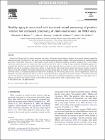| dc.contributor.author | KEHOE, ELIZABETH | en |
| dc.contributor.author | BALSTERS, JOSHUA | en |
| dc.contributor.author | BOKDE, ARUN | en |
| dc.date.accessioned | 2013-08-26T10:56:09Z | |
| dc.date.available | 2013-08-26T10:56:09Z | |
| dc.date.issued | 2013 | en |
| dc.date.submitted | 2013 | en |
| dc.identifier.citation | Kehoe EG, Toomey JM, Balsters JH, Bokde AL., Healthy aging is associated with increased neural processing of positive valence but attenuated processing of emotional arousal: an fMRI study, Neurobiology of Aging, 34, 3, 2013, 809-821 | en |
| dc.identifier.other | Y | en |
| dc.identifier.uri | http://hdl.handle.net/2262/67242 | |
| dc.description | PUBLISHED | en |
| dc.description.abstract | Arousal and valence play key roles in emotional perception, with normal aging leading to changes in the neural substrates supporting valence processing. The objective of this study was to investigate normal age-related changes in the neural substrates of emotional arousal processing. Twenty-three young and 23 older, healthy women underwent functional magnetic resonance imaging as they viewed images which were neutral or positive in valence and which varied in arousal level from low to high. Using a parametric modulation approach, we examined how the blood oxygen-level dependent signal varied with single trial subjective ratings of valence and arousal, and whether this differed with age. In accordance with previous studies we found that the older group showed greater activation in response to positive valence, in the left amygdala, left middle temporal gyrus and right lingual gyrus. In contrast however, they showed reduced reactivity to emotional arousal, in occipital and temporal visual cortices bilaterally, the left inferior parietal cortex, and the supplementary motor area bilaterally. This study represents the first of its kind to clearly dissociate how aging affects the neural correlates of emotional arousal and valence. The changes in arousal processing may in part be mediated by the functional reorganization evident in the aging brain, such as reduced activation of the posterior cortices as described by the posterior-anterior shift in ageing (PASA) effect. | en |
| dc.format.extent | 809-821 | en |
| dc.language.iso | en | en |
| dc.relation.ispartofseries | Neurobiology of Aging | en |
| dc.relation.ispartofseries | 34 | en |
| dc.relation.ispartofseries | 3 | en |
| dc.rights | Y | en |
| dc.subject | Neuroimaging | en |
| dc.subject | Ageing | en |
| dc.title | Healthy aging is associated with increased neural processing of positive valence but attenuated processing of emotional arousal: an fMRI study | en |
| dc.type | Journal Article | en |
| dc.type.supercollection | scholarly_publications | en |
| dc.type.supercollection | refereed_publications | en |
| dc.identifier.peoplefinderurl | http://people.tcd.ie/kehoee2 | en |
| dc.identifier.peoplefinderurl | http://people.tcd.ie/balsterj | en |
| dc.identifier.peoplefinderurl | http://people.tcd.ie/bokdea | en |
| dc.identifier.rssinternalid | 81020 | en |
| dc.identifier.doi | http://dx.doi.org/10.1016/j.neurobiolaging.2012.07.006 | en |
| dc.subject.TCDTheme | Ageing | en |
| dc.subject.TCDTheme | Neuroscience | en |




